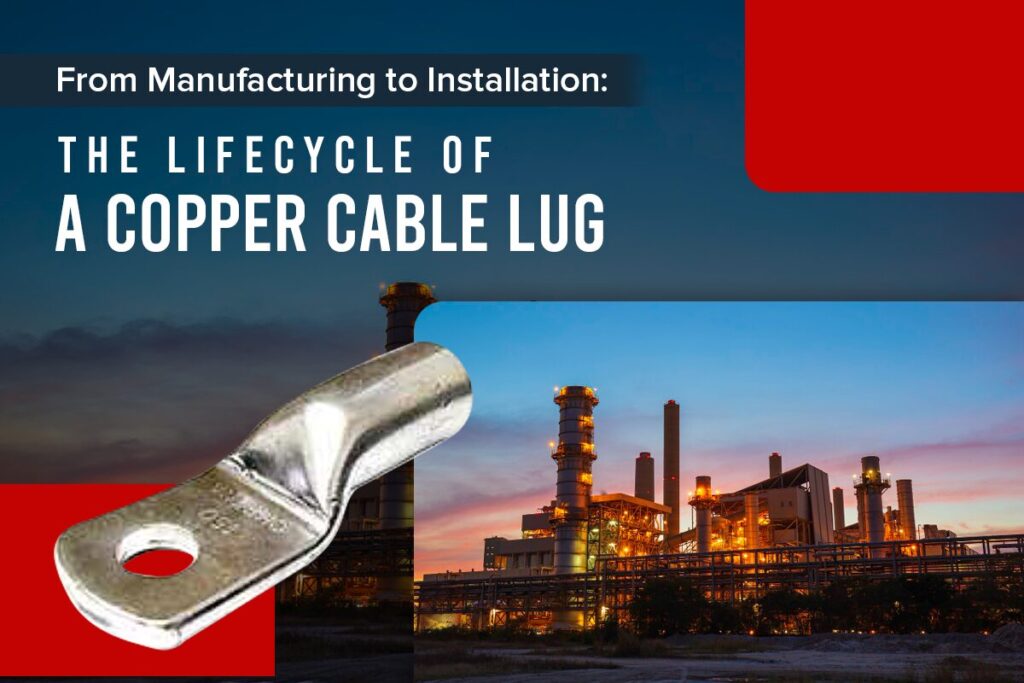Lugs are one of the most important components of an electrical system – they are used to connect cables to terminals, junctions, or equipment securely. Even though they are small in size, their role is critical to ensure the safety and efficiency of an electrical system.
The key aspects when it comes to the lifecycle of copper cable lugs are precision, understanding the material, and quality control. In this blog, we will dive into its journey from manufacturing to installation
Let’s get started!
Selecting the raw material
The first and foremost decision you have to make when beginning the manufacturing of a cable lug is the right material. The selection of material can significantly impact the performance of your electrical system. Many times, the most popularly chosen material is copper for its exceptional conductivity of electricity, resistance to corrosion, and other such properties that make it a great fit.
Generally, manufacturers use EC grade copper, which is known to be 99.9% pure. This is mainly because such copper has the least electrical resistance and the highest high-load performance. The quality of copper used in the manufacturing of such lugs is critical, because even in small amounts, impurities can affect the performance of the lugs, their conductivity, and their safety.
Designing
Copper lugs are available in many different shapes and sizes, right from small lugs that can be used in control panels to larger, heavy-duty lugs that are appropriate for high-load industrial power lines. In this stage of the lifecycle of a lug, you have to calculate the thickness of the material in order to align with the load, the diameter of the hole for fitting the bolt, the treatments required on the surface of the lug, and more.
In today’s world, a number of manufacturers utilise 3D modeling software to create designs and prototypes that meet all the international standards for testing, safety, and efficiency.
Manufacturing
Cutting
The manufacturing process of cable lugs made of copper begins with cutting the copper sheets into the desired sizes using tools that ensure precision. You can achieve the foundational shape of the lug by stamping or cold forging, as it helps to boost the strength of the copper without impacting its conductivity.
Shaping
You need to create a barrel shape in the lug as it holds the cable. It can be formed into a cylindrical shape by using automated machines. The inner hollow part of the cylinder can be hollowed cylinder made using automated machines, the inside of which may be curved for better grip on the cable strands.
Drilling a hole
Another important shape to be formed while manufacturing is the flat part of the copper cable lug, which is shaped like a palm. You need to drill a hole in the palm for bolting – the more connections you need, the more holes you will have to drill in the palm.
Annealing
Annealing is a process that involves heating a material to a certain temperature to modify its physical or chemical properties. It can make the metal more flexible and bendable, reduce its hardness by relieving its internal stress, and improve its flexibility. This process is important for lugs that are to be used for flexible applications.
Surface treatment
When it comes to lugs, copper is used for its unmatched conductivity and resistance to corrosion. However, these lugs are treated with tin to avoid oxidation, extending the lifespan of the lug. When these lugs are subjected to an industrial atmosphere or marine environment, treating the surface with a tin coating comes in handy.
Quality checks
After the manufacturing process is complete, each lug undergoes rigorous quality checks and control measures to ensure that the lugs are efficient and safe to use. During such checks, the dimensional accuracy of the lugs is measured, their conductivity is thoroughly checked to ensure electrical performance, their tensile strength is tested for mechanical assurance, along with other tests for corrosion resistance and ensuring real-time applications.
Packaging
The next step after quality check is packaging and distribution. Cable lug manufacturers in India clean, dry, pack, and ship to wholesalers and retailers. Each box is labelled correctly with the size, type of lugs, and more identification details. These can be directly distributed to industrial customers, contractors, and more such prospective buyers.
On-site arrangements
Before using them on-site, there are some preparations that technicians and electrical engineers undertake. This involves cutting the cable to the required length, cleaning the ends of the conductor to ensure that there are no contaminants or oxidation, and exposing the bare copper conductor by removing all insulation.
To make sure that it is a proper fit, you need to ensure that the cable and the lug sizes are exactly the same. This can create a safe, efficient, and reliable electrical contact.
Crimping
Crimping refers to the process of attaching the lug to the cable. It is a very delicate process which needs to be performed with precision. There are also different tools to use depending on the size of the lug.
If crimping is done properly, the lug barrel is compressed around the cable strands. This can ensure low electrical resistance as well as mechanical strength. On the other hand, if there are issues with your crimping process, it can lead to power loss, overheating, or even fires.
Once installed, these copper cable lugs last for years, even decades.
Final thoughts
To sum it up, the lifecycle of a cable lug made of copper is diverse – it transmits electricity safely after being optimised for safety, durability, and performance like never before. These lugs may appear to be simple, but their importance in an electrical system is substantial.

